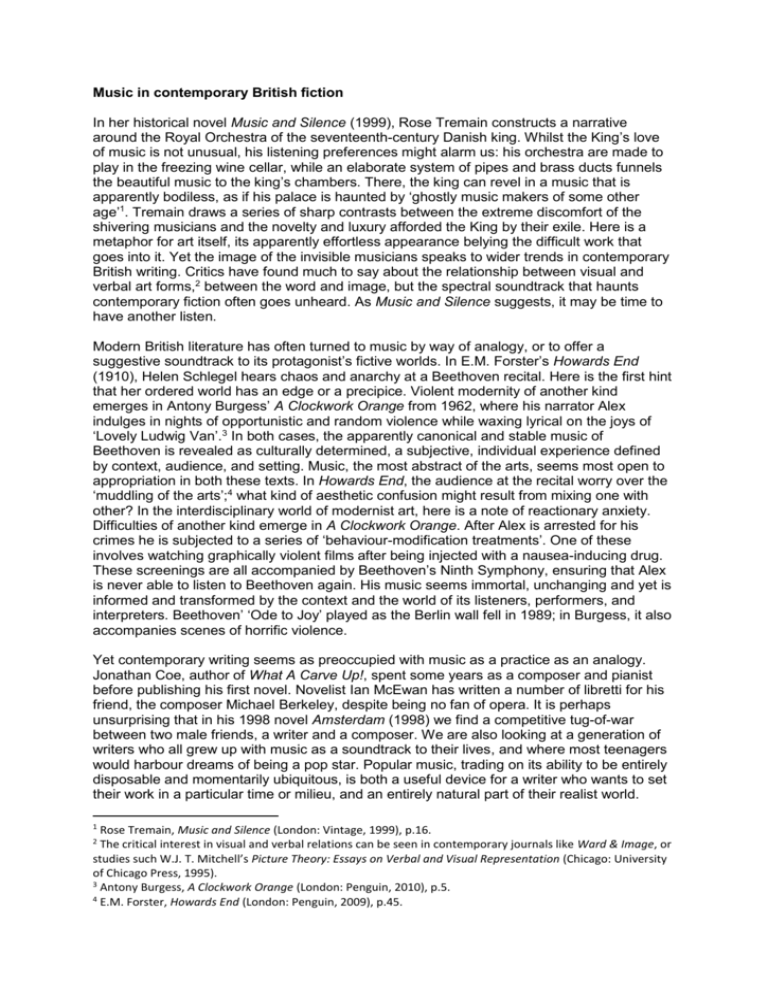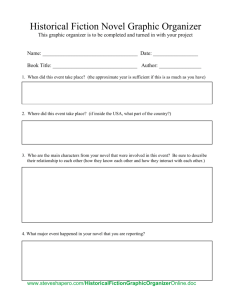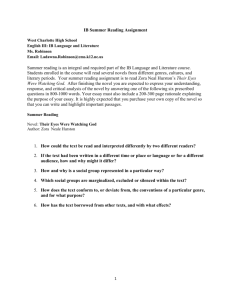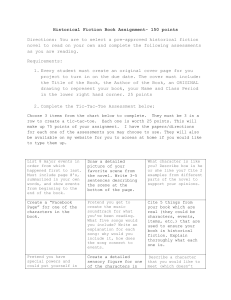Music in contemporary British fiction
advertisement

Music in contemporary British fiction In her historical novel Music and Silence (1999), Rose Tremain constructs a narrative around the Royal Orchestra of the seventeenth-century Danish king. Whilst the King’s love of music is not unusual, his listening preferences might alarm us: his orchestra are made to play in the freezing wine cellar, while an elaborate system of pipes and brass ducts funnels the beautiful music to the king’s chambers. There, the king can revel in a music that is apparently bodiless, as if his palace is haunted by ‘ghostly music makers of some other age’1. Tremain draws a series of sharp contrasts between the extreme discomfort of the shivering musicians and the novelty and luxury afforded the King by their exile. Here is a metaphor for art itself, its apparently effortless appearance belying the difficult work that goes into it. Yet the image of the invisible musicians speaks to wider trends in contemporary British writing. Critics have found much to say about the relationship between visual and verbal art forms,2 between the word and image, but the spectral soundtrack that haunts contemporary fiction often goes unheard. As Music and Silence suggests, it may be time to have another listen. Modern British literature has often turned to music by way of analogy, or to offer a suggestive soundtrack to its protagonist’s fictive worlds. In E.M. Forster’s Howards End (1910), Helen Schlegel hears chaos and anarchy at a Beethoven recital. Here is the first hint that her ordered world has an edge or a precipice. Violent modernity of another kind emerges in Antony Burgess’ A Clockwork Orange from 1962, where his narrator Alex indulges in nights of opportunistic and random violence while waxing lyrical on the joys of ‘Lovely Ludwig Van’.3 In both cases, the apparently canonical and stable music of Beethoven is revealed as culturally determined, a subjective, individual experience defined by context, audience, and setting. Music, the most abstract of the arts, seems most open to appropriation in both these texts. In Howards End, the audience at the recital worry over the ‘muddling of the arts’;4 what kind of aesthetic confusion might result from mixing one with other? In the interdisciplinary world of modernist art, here is a note of reactionary anxiety. Difficulties of another kind emerge in A Clockwork Orange. After Alex is arrested for his crimes he is subjected to a series of ‘behaviour-modification treatments’. One of these involves watching graphically violent films after being injected with a nausea-inducing drug. These screenings are all accompanied by Beethoven’s Ninth Symphony, ensuring that Alex is never able to listen to Beethoven again. His music seems immortal, unchanging and yet is informed and transformed by the context and the world of its listeners, performers, and interpreters. Beethoven’ ‘Ode to Joy’ played as the Berlin wall fell in 1989; in Burgess, it also accompanies scenes of horrific violence. Yet contemporary writing seems as preoccupied with music as a practice as an analogy. Jonathan Coe, author of What A Carve Up!, spent some years as a composer and pianist before publishing his first novel. Novelist Ian McEwan has written a number of libretti for his friend, the composer Michael Berkeley, despite being no fan of opera. It is perhaps unsurprising that in his 1998 novel Amsterdam (1998) we find a competitive tug-of-war between two male friends, a writer and a composer. We are also looking at a generation of writers who all grew up with music as a soundtrack to their lives, and where most teenagers would harbour dreams of being a pop star. Popular music, trading on its ability to be entirely disposable and momentarily ubiquitous, is both a useful device for a writer who wants to set their work in a particular time or milieu, and an entirely natural part of their realist world. 1 Rose Tremain, Music and Silence (London: Vintage, 1999), p.16. The critical interest in visual and verbal relations can be seen in contemporary journals like Ward & Image, or studies such W.J. T. Mitchell’s Picture Theory: Essays on Verbal and Visual Representation (Chicago: University of Chicago Press, 1995). 3 Antony Burgess, A Clockwork Orange (London: Penguin, 2010), p.5. 4 E.M. Forster, Howards End (London: Penguin, 2009), p.45. 2 Zadie Smith’s novel On Beauty (2005) shows a character self-consciously using music to soundtrack their world. Consider the following sentence: ‘As sometimes happens, the song playing in Levi’s headphones ended the moment he put his hand to the gate of 83 Langham’.5 By sheer coincidence, her character is able to sustain the illusion that he is in a film, and while he can’t choose what happens to him, he can choose the soundtrack that accompanies what happens to him. Other writers pick up on this idea of music as a perpetual soundtrack. Poet and author Lavinia Greenlaw published a memoir entitled The Importance of Music for Girls in 2008; the same year also brought us Simon Armitage’s Gig: Memoirs of a Rock Star Fantasist. For these writers (who have also worked as librettists), popular music is both the social glue of adolescence and a private realm of fantasy, offering them the chance to indulge in unfulfilled ambitions. Yet in Grace Notes we find much more than a novelist dreaming about the life of his composer-protagonist, Catherine. While Bernard MacLaverty presents us a protagonist struggling with a very particular set of personal circumstances, he is always alive to the social, political and religious implications of Catherine’s music even if, as the novel admits, contemporary classical music seems destined to inhabit a world populated only by fellow composers and BBC Radio 3 music producers. As a music student, Catherine finds herself always on the defensive and keen to engage in politics, reading to roll up her sleeves and get stuck into a pub debate on Britain and Ireland only to realise the discussion is about the relative merits of the composers Benjamin Britten and John Ireland.6 Yet, in maturity, the Roman Catholic Catherine chooses Protestant drums for her symphony because, simply, she ‘likes the sound’ of them, and the way they inspire ‘intense feelings’ (105); the press are reluctant to take this on trust. As her old teacher Miss Bingham notes, ‘all they want is a story about cementing the divide, or bridging the sectarian gulf’ (105). Here, contemporary music is given impossible political mandates to fulfill. It’s telling that MacLaverty uses the word ‘story’ to describe the expectations of Catherine’s music. Himself an Irish novelist working and writing in Glasgow, each new novel carries the weight of critical expectations that he might respond to the political climate of his birthplace. Yet we might ask whether the novel itself is not complicit in this process. Through the guise of a composer shrugging off the political affiliations of their art, MacLaverty is both able to distance himself from the need to write ‘about’ Northern Ireland, and to second-guess how his protagonists’ music might be read by the novel’s reviewers and critics. MacLaverty shows us not only how music might unite disparate or warring communities, but also how reductive our view of it might be if it is only a political hobby-horse. At the same time, as both Catherine and MacLaverty are aware, to wrestle with these themes is also to create an expectant audience for your work. It is no surprise that Grace Notes was nominated for the Booker Prize, the only one of MacLaverty’s works to achieve this accolade. Catherine, too, resists being merely a ‘contemporary composer’ by the range of provocative political positions she takes up, often knowingly. She writes a mass aware that her gender puts her at odds with the patriarchal church upbringing that inspired her. ‘How dare you!’ cries her mother, when Catherine finds in the mass only ‘a great structure’ and not a devotional text to aspire towards (89). Catherine’s music becomes not an expression of her faith or her political affiliation, but a replacement for it. If political and religious rhythms animate her work and create a listening context for it, her art apparently stands in for faith in a secular world. For many other contemporary British writers, often secular, yet, if responding to classical music, most likely engaging with a complex set of religious traditions, music is the way they choose to explore faith itself. Zadie Smith most recent novel On Beauty (2005) jumps between New England and London, as it follows the fortunes of two warring families, the 5 Zadie Smith, On Beauty (London: Vintage, 2005), p.82. Bernard MacLaverty, Grace Notes (London: Vintage, 2007), p.22. All subsequent references are parenthesised in the text. 6 Belseys and the Kippses. The families are headed by two academic rivals, who are left and right of the political spectrum. Through their various interactions, Smith explores the virtues of state-supported education versus philanthropy, private acquisition versus community inclusion, American individualism versus liberal consensus. Smith’s admiration of E.M. Forster is no secret, and the first line begins with a rewrite of Forster’s Howards End: ;one many as well begin with their emails’ (5). The debt continues throughout the novel as the characters deal with the legacy of a family house now up for sale, a precious family heirloom mysteriously left to someone who is apparently no part of the family at all, and the responsibilities of educational institutions to provide resources to all those who might benefit from them, rather than just the wealthy. It in this guise we learn of Carl Thomas, a black hiphop enthusiast without a college education, whose natural abilities and enthusiasm for music and literature lead to him being given a job at the prestigious Wellington University as ‘hiphop archivist’. Like Leonard Bast’s attempt to educate himself into the middle-classes in Howards End, Carl never assimilates. He avoids death, but ends up disillusioned, sure he is only ‘just some experiment for [the middle-class] to play with’ (418). Yet one of the novel’s most telling musical allusions comes in Smith’s rewriting of the scene where Helen Schlegel goes to a Beethoven recital, and then accidentally meets Leonard Bast, with whom she will eventually have a child. In On Beauty, the musical occasion is a performance of Mozart’s Requiem. The Belseys agree to attend reluctantly: the son, Jerome, is wary about meeting Victoria Kipps, a girl he once believed was in love with him. Howard, his father, is desperate to atone for his adulterous affair with a colleague. Howard’s wife only speaks to him reluctantly; a family outing seems a gesture that may go some way towards his rehabilitation. Smith’s third-person narrative shows us a number of ways of responding to the music. Howard’s wife, Kiki, reflects on the music’s mystery. Her daughter Zora, desperate to get the intellectual maximum from all events, listens to the requiem at the same time as her Discman gives her a running commentary on it over her headphones. Kiki’s son Jerome finds the music has him in tears, and Kiki takes a moment out of her reverie to reflect on her pride that she has raised a black son enamoured of the Western Classical tradition. She imagines addressing an imaginary guild of American black mothers on her success as a parent: And there’s no big secret, not at all, you just need to have faith, I guess’ (71). Kiki’s word ‘faith’ is significant here, and lead us back to the Christian sublime that so offends Howard’s academic sensibilities - as Howard remarks once the performance is over, ‘I just prefer music which isn’t trying to fake me into some metaphysical idea by the back door’ (72).. Smith makes her own perspective clear by switching to second person when describing the music itself. It becomes an authorial voice speaking to us, leading us through the music that both delights her and mystifies her in equal measure: Mozart’s Requiem begins with you walking towards a huge pit. The pit is on the other side of a precipice, which you cannot see over until you are right at its edge. Your death is awaiting you in that pit. […] Your will is a clarinet and your footsteps are attended by all the violins […] This choir is the heavenly host and simultaneously the devil’s army. It is also every person who has changed you during your time on this earth: your many lovers; your family; your enemies, the nameless […] the experience of listening to an hour’s music you barely know in a dead language you do not understand is a strange falling and rising experience. (70) It is, of course, highly unusual to find the second person in a realist novel. The ‘you’ Smith is addressing, after another paragraph, is eventually revealed to be Kiki, the woman who for much of the narrative is the focaliser, the character whose perspective we most often inhabit. We might also be struck that something as totemic as ‘Mozart’s Requiem’ can begin with ‘us’ – what room for the individual in such a well-known work? This is the peculiar genius of this novel, which manages to describe a piece of classical music without falling victim to the preciousness of the connoisseur, or the sneer of the dismissive. This listening is not academically informed; Smith is careful to point out Kiki knows very little Mozart, and very little about him. Yet her openness to the music, and her determined, if faltering attempts to listen to it, tell us something not just about how Smith views music, but how art itself might function in a secular world. Kiki’s mock-effacing comment that ‘you just need to have faith, I guess’ is not a statement excluding the secular, agnostic, or the atheist from Mozart’s work. What you need faith in is your own ability to listen carefully, and then to understand. Through the medium of the concert performance, Smith offers something which, unlike Forster, does not presage chaos and unrest, but the possibility of renewal, comfort, and healing. Following MacLaverty, Smith uses music On Beauty to offer a wonderfully provisional sense of the power of all art, in terms that would never be possible if the Belseys were talking about literature rather than music. By changing art form, Smith allows herself to make an argument for an instinctual, humanist response to literature itself, in ways that avoid the self-conscious intertextuality we might find if her main character was, say, a novelist. We find a similar notional link made by Jonathan Coe in his semi-autographical novels The Rotters’ Club (2001), and the follow-up The Closed Circle (2005). For those of you who have read What A Carve Up!, you might suspect film, rather than music, to be Coe’s first point of reference. But in fact, his semi-fictional protagonist Ben Trotter, like Coe himself, turns first to sound, rather than the visual, harbouring teenage ambitions to write a ‘Birmingham Symphony’ and to set his girlfriend Cecily’s poetry to music. Ben, like Catherine in Grace Notes, is also someone who struggles with their faith, and maps their progression as a composer directly onto this struggle. The comic, self-effacing tone of Coe’s novel, familiar to those of you who have read What A Carve Up!, offers itself as interesting point of comparison to MacLaverty’s novel. Ben’s conversion to Christianity as a teenager is narrated with a bathos typical of Coe. One day at school, Ben realises he has forgotten his swimming trunks, and knows his vindictive P.E. teacher will force him to swim naked in front of his whole class. Naturally shy and self-effacing, but pathologically law-abiding, Ben makes a deal with a God he doesn’t believe in that if, by some means, he could arrange for him to find a pair of swimming trunks in his locker, he will believe in God forever. By pure coincidence, of course, Ben does find a pair of trunks in a locker, committing himself ever after to a life of faith, suddenly convinced that ‘Divine Grace was everywhere’.7 This surge of faith carries him through the rest of the novel, and through the euphoric 14,000-thousand word sentence that ends it. Here, Ben rhapsodises wildly on his great future, the wonderful symphonies he will write, and the complex and dissonant harmonies of his ‘mature period’ (376) which will ensure his longevity in the canon. By Coe’s follow-up novel, The Closed Circle (2005), things look rather different. Ben has split up with his girlfriend, works as an accountant, and, seems despondent and mistrusting. He is now a struggling novelist, having laboured for 20 years on a novel called Unrest which he grandly hopes will ‘change the relationship between music and the written word forever’8. The novel never gets written. Ben’s creative block comes as a direct result of his unravelling faith: he later learns the swimming trunks which mysteriously appeared in his school locker were left there by a visiting speaker with a penchant for boys’ underwear. Divine providence is revealed as coincidence; his faith is misplaced, and crumbles altogether. As in Smith’s On Beauty, Ben’s faltering faith in his music offer an analogy for the novelist struggling to find forms and techniques that will serve his craft. In Grace Notes, by contrast, we are invited to see Catherine’s journey through the novel as a re-affirmation of her faith in music, and of music itself as act of faith. The novel is saturated in religious images. Miss Bingham reminds Catherine that the painter Vermeer ‘turned to the ordinary’ and ‘made saints of you, me and the likes of us’. Another teacher reminds her that ‘music is a way of praying, a way of receiving God’s grace’. While Catherine’s child is no immaculate conception, the novel is careful to surround her with the possibility of the divine. 7 8 Jonathan Coe, The Rotters’ Club (London: Vintage, 2001), p.72. Jonathan Coe, The Closed Circle (London: Vintage, 2005), p.78. However, MacLaverty’s novel is also effective in debunking myths about music, or the ethereal way it might be appropriated. Roland Barthes has written that once music is reified in language, all it offers us is a metaphor, and metaphors can do difficult, as well as useful work for us.9 Yet Grace Notes largely avoids the tendency to make the composer-artist a martyr or a mystic sage; compare, for example, the portentous treatment of a professional string quartet in Vicar Seth’s novel An Equal Music. Catherine remains clear-sighted of the ironies that while the saint of music is female, a composer is always assumed to be male. More particularly Grace Notes uncover the illusions that inform our cultural conceptions of music. At 11, after passing her first music exam, Catherine looks up the patron saint of music St. Cecilia, discovering she was a Roman woman who converted her husband, remained a virgin, and was executed after refusing to engage in an act of idolatry. What she only later discovers is that Cecilia’s connection with music is non-existent. A misreading of a Latin text, which said that pipes were played on her wedding day, meant that she was often pictured playing the organ. A female icon of music builds their reputation on ‘a duff translation’ (155); Catherine gives up idolatry to construct her own musical language. By asking us to identify and then re-identify the relationship between music and a range of social and cultural associations, MacLaverty does not turn to the easy comforts of the nonreferential, but asks us to rethink how we impose meaning on the most abstract art form of all. 9 Roland Barthes, Image-Music-Text (London: Fontana, 1977), p.45.







